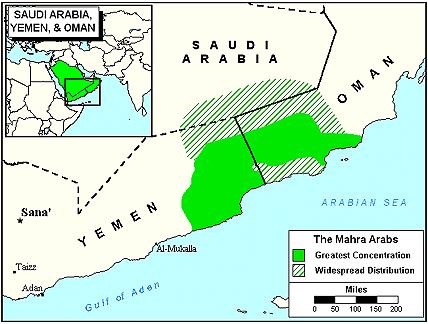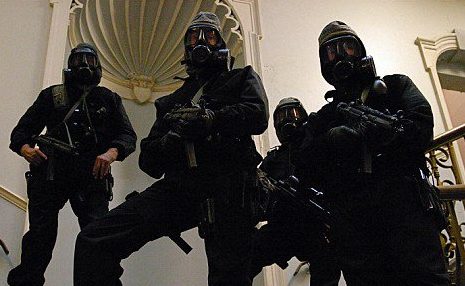This is the second part of the article regarding SAS involvement in proxy operations during the Cold War. You can read Part I here.
Historically, the Mahra tribe had lived in a tri-border area that overlays Saudi Arabia, South Yemen, and Dhofar. After the British withdrew from South Yemen in 1967, and the country went communist, the Mahra were exiled from their tribal lands.

The Mahra tribal lands (Facebook).
In 1969, a Mahra leader requested Omani support to start a rebellion in his homeland. Sensing a fine opportunity to frustrate an undeclared enemy and the adoo’s haven, Qaboos’ father agreed to help them. And when Qaboos assumed power a year later, he significantly increased the support.
London, however, was sceptical about the merits of proxy war and cross-border operations in South Yemen. SAF’s leadership, who were seconded British officers, mirrored its scepticism.
Both feared an escalation that would either require further British support — thereby hurting its Northern Ireland and Cold War commitments — or a withdrawal of current support from the Sultanate — thereby risking Oman going communist, with the concomitant danger to the Strait of Hormuz and West’s oil supply.
With or without the British, however, Qaboos was going for it. So, it was thought best to humour him — thus controlling the amount of escalation, whilst satisfying his desire for reprisals.
For that reason, London reviewed the progress of Operation Dhib every six months, gauging its effect on South Yemen and the communist response.
From 1971 to 1975, Oman and Britain funded, equipped, and trained (only after 1973) Mahra firqats. And as with their Dhofari counterparts, it fell to Britain’s special operators to shape the Mahra into a fighting force.
In early 1973, six SAS troopers were given the job. Cloaked behind the regular firqat training scheme, they mashed together a group of undisciplined tribesmen into a respectable raiding force. But that’s where their involvement ended — they were forbidden to accompany the Mahra inside South Yemen. “Any breach of security,” warned the British Prime Minister Edward Heath, “could lead to an immediate withdrawal of the SAS team and a [denial] of SAS involvement.”
Already have an account? Sign In
Two ways to continue to read this article.
Subscribe
$1.99
every 4 weeks
- Unlimited access to all articles
- Support independent journalism
- Ad-free reading experience
Subscribe Now
Recurring Monthly. Cancel Anytime.
The British connection had to be denied at all costs. And as U.S. Special Forces recce teams in Laos and Cambodia often operated sterile of any US identification, so the weapons and gear given to the Mahra were foreign, preferably from Soviet bloc countries.
Once ready, the Mahra were to conduct cross-border raids and proxy warfare. Roads would be mined, military vehicles and installations would be sabotaged, and Yemeni and adoo convoys would be raided.
In the autumn of 1971, Firqat al-Badiya, literally meaning the desert militia, was formed. It came from a northern Mahra tribe, and throughout Operation Dhib’s life, it served as its main force. At first, the firqat only patrolled the Oman-Yemen border. But in early 1973, with their newly received SAS advisers, it was relocated 70 miles from the border and turned aggressive.
In May of 1973, about 30 Mahra firqatmen ambushed a South Yemeni military convoy inside South Yemen. They destroyed seven trucks, killed 22 soldiers, and vanished back across the Omani border with a prisoner for interrogation.
The British thought it was quite effective. The firqat’s small footprint and, especially, the intelligence on South Yemen’s military capabilities it gathered satisfied London.
But Qaboos’ appetite for revenge was unsatisfied, and it grew even larger. He demanded an immediate expansion of the raids.
Contradicting his wish, the British paused any cross-border operations in the autumn because of increasing Yemeni reactions. They did, however, acquiesce to the formation of second Mahra firqat, this time from a southern tribe. A second SAS team was dispatched to train it in January of 1974. Operations didn’t resume until March. Over the next six months, the Firqat al-Badiya carried out three raids, killing at least 20 Yemeni soldiers and adoo fighters.
But then things started to get complicated. Qaboos still wanted more retaliation. And the southern Mahra wanted an independent state. Both were incompatible with Britain’s wish of containment. Seeing a lack of discipline in the southern Mahra firqatmen and the possibility of it going rogue, its SAS team was withdrawn and reassigned to the counterinsurgency efforts inside Oman.
Further complicating things for the British was the presence of two other Mahra groups active at the time. One was backed by Saudi Arabia and pursued its own agenda inside South Yemen; the other was Qaboos’ personal force of 250 Mahra, raised without British awareness. There is no further knowledge about these formations.
Firqat al-Badiya, meanwhile, continued to receive SAS support at least until early 1975. Due to the classified nature of Operation Dhib, it’s uncertain when the team was withdrawn.
And here ends all declassified evidence of Operation Dhib.
It was a rather peculiar operation. For it tried to influence the policy of an ally rather than that of an enemy.












COMMENTS
You must become a subscriber or login to view or post comments on this article.